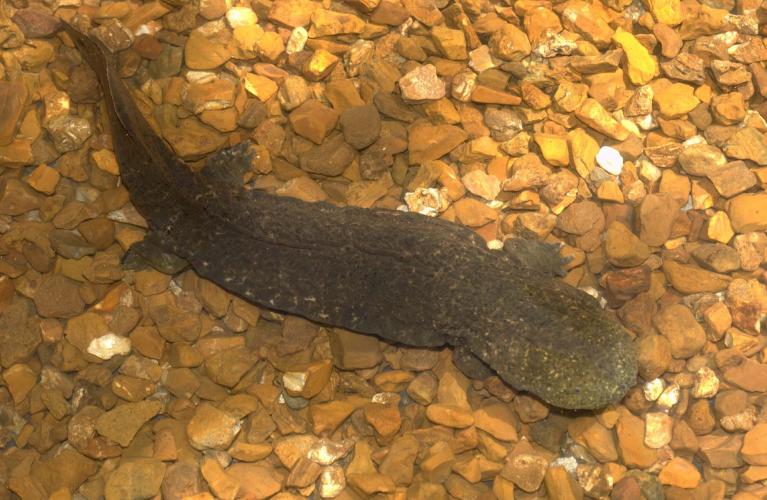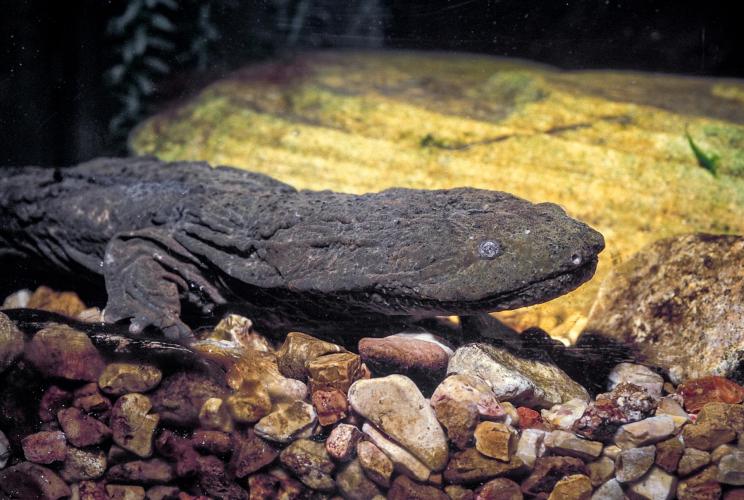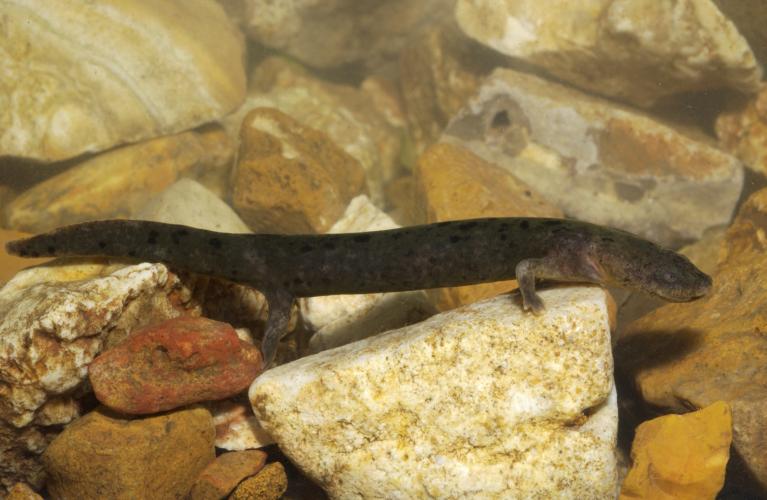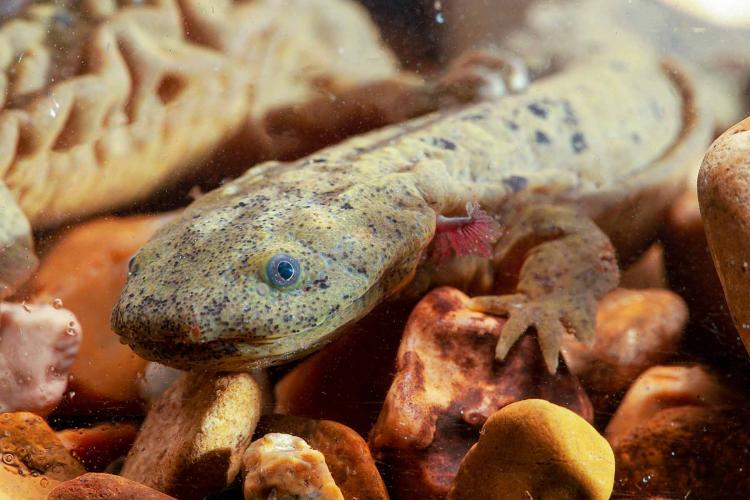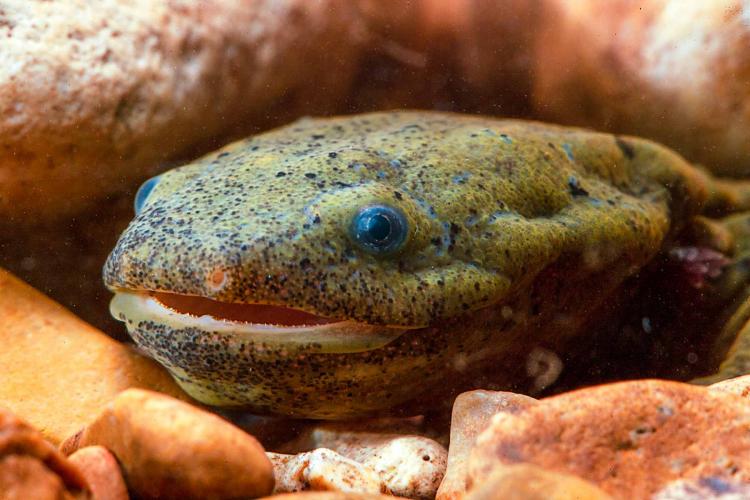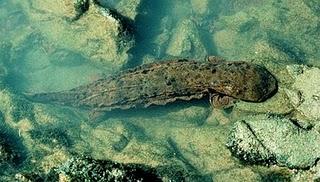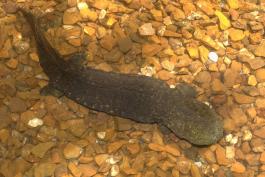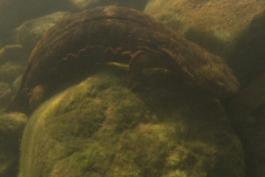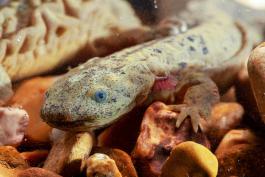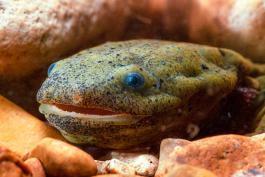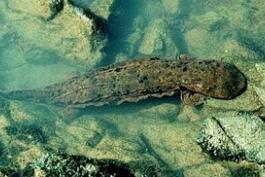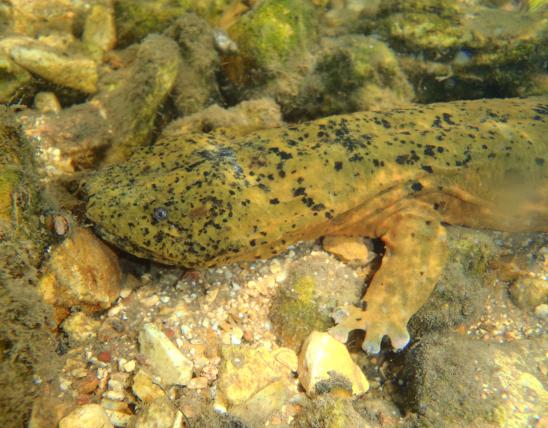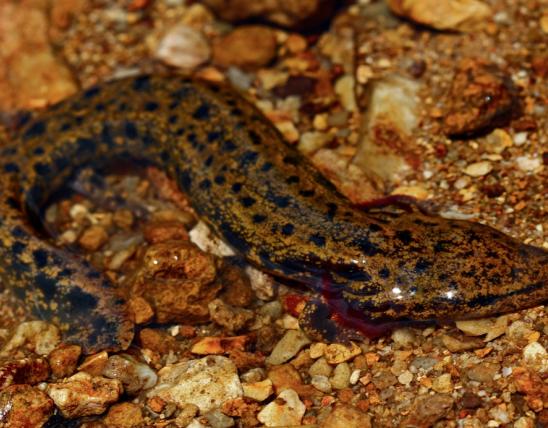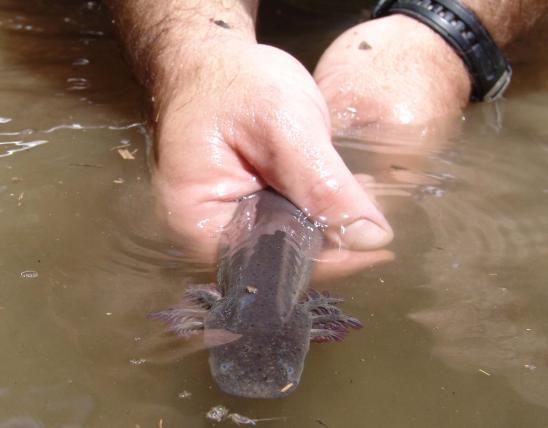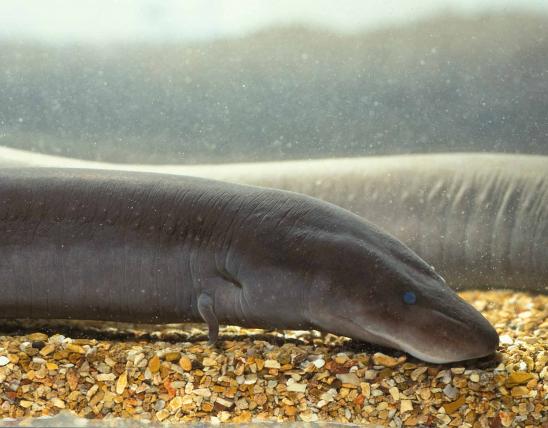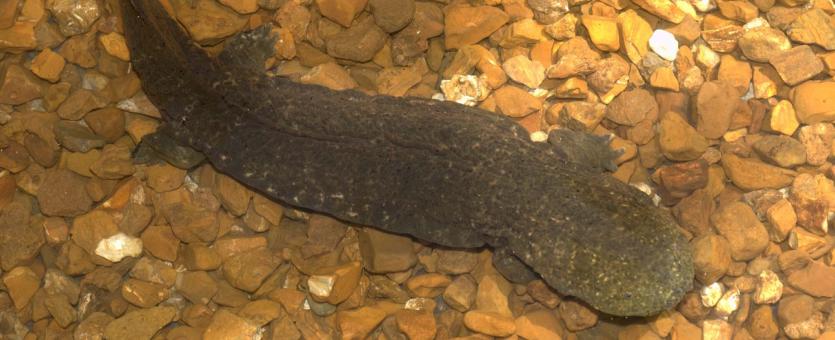
Hellbenders are large aquatic salamanders. They have a wide, flat head with tiny eyes and a broad and vertically compressed, rudderlike tail. The body and legs are covered with prominent folds of skin.
Missouri is the only state that contains both recognized subspecies of North American hellbenders. Both have experienced marked declines and are species of conservation concern. The current taxonomy of hellbenders will likely be changed soon with the elevation of additional species and subspecies.
The eastern hellbender (subspecies) is a large, entirely aquatic salamander. Its head is broad and flat, with small, lidless eyes. The sides of the body have soft, pronounced folds of skin. The legs also have large flaps of skin. The tail is flattened and rudderlike. A gill opening is present on each side of the head. Body color varies from red brown to dull gray brown. Brown to black irregular spots are often present on juveniles, but adults are typically uniform in color. The chin and lower lip usually lack dark markings or spots. The belly is a uniform dark tan or grayish brown and is lighter in color than the rest of the body; however, during the breeding season the belly can be orange.
Similar species: The Ozark hellbender subspecies (Cryptobranchus alleganiensis bishopi is very similar. Its adult size averages slightly smaller (10–21 inches) (as opposed to 13–23 inches for eastern hellbender); it is gray brown to olive green above, and the body has large dark markings and blotching. Perhaps the easiest way to distinguish it is by its different geography: it occurs in south-flowing rivers in the southern Missouri Ozarks (as opposed to north- and northeast-flowing rivers in the northern Missouri Ozarks).
Also similar to hellbenders are mudpuppies (Necturus spp.); mudpuppies, however, have external gills, which are red and plumelike, behind the head on both sides. They have 4 toes on each foot. As adults, mudpuppies reach only 8–13 inches in length. Hellbenders lose their external gills once they reach 4 or 5 inches long, they have 4 toes on the forelimbs and 5 toes on the hind limbs, and their total length may reach 24 inches.
Adult length: usually 13–23 inches; they have been known to reach 29 inches. (Thus, on average, they are slightly larger than the Ozark hellbender subspecies.)
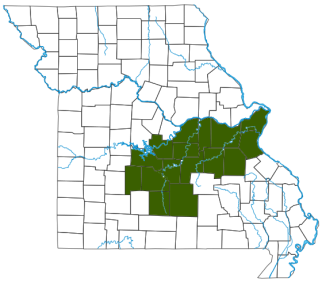
In Missouri, the eastern hellbender (subspecies) occurs in the northern Ozark highlands in spring-fed rivers that drain north or northeast into the Missouri River and Meramec River drainages. Its distribution is different from that of the Ozark hellbender subspecies and thus is a key ID character.
Habitat and Conservation
Hellbenders are well suited for an aquatic existence. Their flat head and streamlined shape reduce water resistance. This salamander lives under flat rocks and in bedrock crevices in large permanent streams and rivers. It is a slow swimmer and often moves by walking along the bottom. It is normally a solitary animal and prefers cover.
Hellbenders are declining and are listed as an endangered species. They need clean, clear, cool rivers to survive, and they should never be harmed or removed from the wild.
Food
The food of adult eastern hellbenders consists primarily of crayfish, small fish, and occasionally snails, worms, and aquatic insects. It is also known to eat scavenged material. In the wild, larval eastern hellbenders are known to feed on various aquatic insects.
Status
Both subspecies of hellbenders that occur in Missouri are listed as endangered by both the state of Missouri and by the federal government. They may become extinct in our state in less than 20 years. None may be taken from the wild for any use. Eastern hellbenders are often caught by anglers. If caught on hook-and-line, hellbenders should be released unharmed.
Eastern hellbenders in Missouri have experienced a marked decline since the 1970s (80 percent decline) with larger, mature individuals mostly observed today and few observations of juvenile individuals. Due to the dramatic population decline, the Missouri Department of Conservation listed the eastern hellbender as state endangered in 2003, and in 2021 the U.S. Fish and Wildlife Service listed it as federally endangered.
Hellbenders are habitat specialists that depend on consistent levels of flow, temperature, and dissolved oxygen, as well as large rocky habitat for shelter. Habitat alteration and degradation resulting from excessive sediment input from the surrounding landscape are a major threat to this species, as well as degraded water quality, illegal collecting, predation, and disease. Increased efforts to collect eggs from the wild and rear young at the Saint Louis Zoo are occurring to bolster wild populations and ensure this animal remains a part of Missouri’s biodiversity.
Taxonomy: Recent genetic studies seem to show that the eastern hellbender and the Ozark hellbender should both be elevated to full species status. In addition, there are apparently several distinct lineages throughout the North American range, meaning that it's possible there are additional distinct species. It is likely the disjunct population of the eastern hellbender in Missouri will be classified as one of the distinct species or subspecies as information is published.
Life Cycle
These fully aquatic salamanders take in oxygen through their skin. By day, they hide under large flat rocks; by night, they walk slowly along the stream bottom, hunting.
Breeding in Missouri is mainly in September, with adults typically congregating in groups of about 6–12 adults for courtship and mating. Fertilization is external, about 200–400 eggs may be deposited into the nest, and the males guard the eggs. The eggs hatch in about 45 days. Females become sexually mature at about 6–8 years of age; males at about 5–6 years of age.
Human Connections
Hellbenders are a major indicator of the overall health of a river or stream. If there is something in the water causing their numbers to decline, it can affect other species as well, including us.
In 2019, the hellbender was designated as the official endangered species for the state of Missouri. At the time that legislation passed, Missouri had 70 species of plants and animals listed as state-endangered, 27 species on the federal endangered list, 15 species on the federal threatened list, and 1 species being considered as a candidate for federal listing.
A number of organizations, including MDC, are partnering with the Saint Louis Zoo in a captive breeding program for hellbenders, reintroducing them into the wild, with an aim to increasing their numbers in wild populations and ensure this animal remains a part of Missouri's biodiversity.
Ecosystem Connections
Hellbenders are part of a healthy natural aquatic environment, and they play an important role in maintaining crayfish populations.
Hellbenders have been on our continent for more than 6 million years and are a unique part of our wildlife heritage.
North America's hellbenders are members of only two genera in the family Cryptobranchidae. The other genus, Andrias, occurs strictly in Asia and comprises only two living forms, the Chinese and Japanese giant salamanders (A. davidianus and A. japonicus, respectively); members of the Asian genus may grow to 5 feet in length. The Chinese species is critically endangered.
